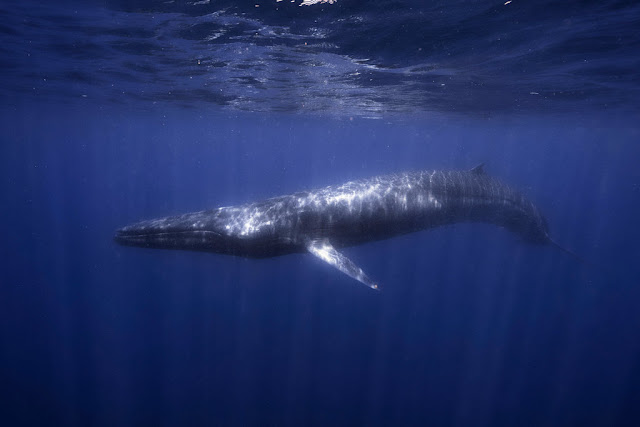Friday, 5 April 2019
The rare Omura’s whale
The
New York Times,
22 March 2019:
An
Omura’s whale in waters off Madagascar in the Indian Ocean. CreditCreditGabriel
Barathieu/Biosphoto, via Alamy
Salvatore Cerchio
stunned the small world of whale science in 2015 when he found examples of a new species in the
wild for the first time. Now, he’s mapped the habitat of that species, called
Omura’s whale after Hideo Omura, a prominent Japanese whale biologist.
The surprise in the
new study, published in Frontiers in Marine
Science, is that Omura’s whales, though little seen, are widespread across the
tropical world.
Dr. Cerchio, a
researcher with the New England Aquarium in Boston, found a population off the
northwest coast of Madagascar,
where he works, and compiled reports of sightings from Japan, Australia, Brazil
and off the coasts of Indonesia, among others. In total, from photographs,
audio recordings, museums and documents, he identified 161 accounts of Omura’s
whales in 95 locales.
Scientists said the
finding is a reminder of how little we actually know about what goes on in the
world’s oceans….
Japanese researchers
first identified Omura’s whales in 2003, based on
a 1998 stranding in Japan and tissue from eight animals killed during Japanese
scientific whaling operations in the 1970s. The Omura’s whales have relatively
small bodies, distinct genetics and unusually shaped skulls, leading
researchers to conclude that the new
species had split off from its genetic cousins 17 million years earlier.
Omura’s whales are
baleen whales, meaning they are filter feeders, and they can be identified by
their asymmetric coloration. The right side of their jaws are white, with a
swirling, smoky splash of light coloration and four bisecting dark stripes on
the right side of their heads, and their backs are decorated with asymmetrical
chevrons. They favor tropical environments more than most whales and don’t
migrate, Dr. Cerchio said.
After publishing his
2015 paper, in which he described more than 40 whales seen in the wild and
expanded their range beyond the Indo-Pacific, Dr. Cerchio said people sent him
pictures of similar looking whales.
“Little by little it
became clear that there were a lot more out there that could be researched and
tallied,” he said.
At the urging of Bob
Brownell, the paper’s senior author, Dr. Cerchio counted images he received,
those he’d stumbled across on the internet, as well as sound recordings and
historical sightings dating back to a 1955 magazine article from Hong Kong
University that misidentified an Omura’s whale as an immature fin whale.
Bob Pitman, a scientist
with the National Oceanic and Atmospheric Administration who was not involved
in this research, said he was surprised to learn the scope of the species’
habitat. “I think most of us whale scientists expected that it would have a
small, relatively localized population,” he wrote.
As Mr. Pitman noted, “if
new whales are still being described, it means we are probably also losing
species of animals that we never even knew existed.”
Labels:
marine life,
whales
Subscribe to:
Post Comments (Atom)







No comments:
Post a Comment